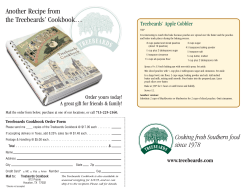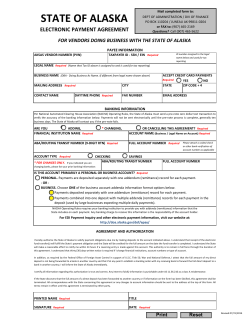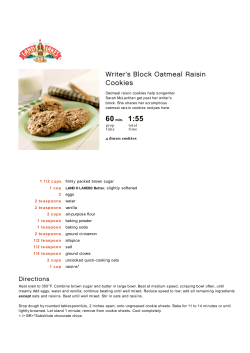
Crabapples
Crabapples by Leslie Shallcross, Extension Faculty and Marci Johnson, Program Assistant Health, Home and Family Development FNH-00109 Crabapple trees are small deciduous trees or shrubs valuable for landscaping, animal habitat and food. The trees produce beautiful, fragrant blossoms in the spring and abundant colorful fruit in late summer and early fall. The small fruit may be harvested or left on the trees as food for birds and other wildlife. Some native species of crabapple yield very small, intensely sour fruit with poor flavor, although many cultivars have been developed that produce flavorful, pleasantly tart and very useful culinary “crabs.” “Crabapple” is the name given to wild North American Malus (apple) species or to any apple with a diameter less than 2 inches. There are many crabapple species native to North America, although only one is native to Alaska — Malus fusca (Raf.) C.K. Schneid., also known as Malus diversifolia, Western crabapple or Oregon crabapple. Malus fusca is found from California to Southcentral Alaska. Wild Alaska crabapples grow on trees or shrubs 6 to 16 feet high. The leaves are oval and up to 3 inches long with toothed edges. Leaves are smooth on top and hairy on the underside. The blossoms have five white petals. The acidic wild crabapple fruit is small, oblong and less than 1 inch long. Trees bloom in June and the fruit ripens in late August through October. Though the fruit from Malus fusca is small and tart, the juice and puree of these small crabs can be added to other wild fruit jams or jellies. Breeding and cultivation work have led to the development of many hardy crabapple cultivars, some of which can survive even the -40°F temperatures found in Interior Alaska. The Ranetka rootstock, developed in Fairbanks to withstand severe cold, came from the Dolgo crabapple and the Siberian crabapple (Malus baccata). Many of the apple and crabapple plants available in Alaska now use this rootstock. Both Siberian and Dolgo crabapple tree varieties grow well in Alaska, producing edible fruit slightly larger than wild crabapples. The trees are taller than wild crabapples and may reach heights of up to 40 feet. The Siberian crabapple tree produces 1-inch fruit; Dolgo crabapples are about 1½ half inches and may be sweet enough to eat right off the tree. Many other crabapple cultivars can be grown successfully in Alaska for their beauty and food uses. The Alaska Pioneer Fruit Growers Association and local Cooperative Extension Service offices can provide information on varieties for each region of Alaska. Nutrition Recent research on apples and crabapples has provided evidence to support the often repeated adage “an apple a day keeps the doctor away.” The amounts of beneficial nutritive compounds vary with the cultivar or variety. Crabapples contain a small but appreciable amount of vitamin C (8 milligrams per 3 ounces of apple) and, depending upon the variety, they may contain significant amounts of antioxidant flavanol compounds. The flavanols anthocyanin (the dark red pigment in some apples) and quercetin may help prevent cancer, heart disease, asthma and diabetes. Crabapples are also high in a fiber called pectin. Pectin is often used for making jelly and jam, but it has also been shown to help reduce blood triglycerides and cholesterol levels and it may lower heart disease risk. In order to get the most of all these beneficial plant compounds, process and consume the fruit with the skin. How to Dry Crabapples make excellent jelly, cider, apple butter and apple sauce. They can also be used in many recipes calling for apples, although they may be very tart and require extra sweetening. In recipes that are not written specifically for crabapples, it is be best to replace only a portion of the apples with crabapples. Because of their small size and tartness, crabapple pieces and rings are not recommended for drying. Crabapple puree may be used like applesauce to make fruit leather. How to Extract Juice Select 4 pounds firm, crisp crabapples, about one-fourth of them firm ripe and the rest fully ripe. Sort, wash and remove stem and blossom ends. Do not pare or core. Cut into small pieces. Place apples and 6½ cups water in a covered saucepan and bring to a boil over high heat. Reduce heat and simmer for 20 to 25 minutes, or until crabapples are soft. Place in a jelly bag or layers of cheesecloth in a colander. Let the juice drip into a bowl. For clear juice, do not twist or press jelly bag or cheesecloth. For long-term storage, the juice should be frozen or canned. Yield: 5 cups Storage and Preservation How to Harvest, Clean and Store Crabapples ripen best with ample sunlight, warm summer days and cool nights. With Alaska’s notably short summer, most people want to leave the apples on the tree as long as possible. Below-freezing temperatures will reduce the quality of crabapples, but apples can tolerate temperatures as low as 27° to 28°F, especially while the leaves are still providing some protection. To avoid bruising crabapples after a frost, do not handle them until they are completely thawed. Crabapples that have been exposed to a frost should be processed quickly and will still make excellent sauce or cider, but they are not suitable for long-term storage and might not even be suitable for pickling or eating fresh because of rapid and extensive enzymatic browning. Hot pack for juice Sterilize canning jars and prepare lids. Heat juice, stirring occasionally, until it begins to boil. Pour into hot jars, leaving ¼ inch headspace. Wipe jar rims. Adjust lids. Process in a boiling water canner. Pints or quarts Half gallons Crabapple ripeness can be determined by exposing the core and seeds — a ripe crabapple will have brown seeds and will be firm and dense. Pick or buy crabapples that are very firm and without any signs of decay. Different cultivars, or varieties, of crabapples will have different storage times. Some will only last for a few days, while others can last for several months. Before storing ripe crabapples, remove debris and carefully sort and discard bruised or damaged fruit. For short-term storage, keep crabapples in a cool place. Crabapples that are hard, mature and in perfect condition can be stored through the winter if kept properly chilled. The optimum storage temperature is 30˚ to 32˚F with 90 percent relative humidity. Apples will pick up off-flavors in storage, so they may need to be kept in plastic bags or otherwise protected from refrigerator odors. 5 minutes 10 minutes How to Prepare Puree Select 3 pounds firm, crisp crabapples, about one-fourth of them slightly underripe and the rest fully ripe. Sort, wash and remove stem and blossom ends, but do not pare or core. Cut into small pieces and add 3 cups water to cover apples. In a covered saucepan, bring to a boil on high heat. Reduce heat and simmer for 20 to 25 minutes. Process fully softened apples through a food mill. Discard skins and seeds. Yield: 5 cups For long-term storage, the puree should be frozen. Canning is not a safe method of preserving puree. How to Freeze • To sterilize canning jars, boil in water for 5 minutes. Whole crabapples, crabapple puree and crabapple juice will freeze well. To freeze whole crabapples, rinse them and remove stem and blossom ends. Freeze in a single layer on a cookie sheet. When frozen, transfer to freezer bags and use within three months. Juice and puree should be put into glass or plastic freezer storage containers with airtight lids. • To prepare two-piece lids (rings and tops), wash, rinse and keep in hot water until ready to use. • If less sugar is desired in recipes calling for pectin, be sure to use no-sugar-needed pectin and follow the instructions on the box. • To use a boiling water canner, see instructions on page 3. 2 Crabapple Butter Recipes 5 cups crabapple puree ½ teaspoon allspice 3 ounces liquid pectin Crabapple Syrup 1 cup crabapple juice 2 cups sugar 1 teaspoon cinnamon 7½ cups sugar Sterilize pint or half-pint canning jars and prepare lids. Open liquid pectin pouch and stand upright in a cup or glass. Measure crabapple puree into a very large saucepan. Add cinnamon, allspice and sugar; mix well. Place over high heat; bring to a full rolling boil and boil hard 1 minute, stirring constantly. Remove from heat; at once stir in liquid pectin. Immediately pour hot apple butter into hot canning jars, leaving ¼ inch headspace. Wipe jar rims and add prepared two-piece lids. Process 5 minutes in a boiling water canner. Yield: 9 cups Combine juice and sugar in saucepan and heat to dissolve the sugar. Continue heating until the mixture reaches 160°F on a candy thermometer; do not boil. The syrup is ready to use over waffles, pancakes, hot biscuits, ice cream and other desserts. The syrup will keep up to six months in the refrigerator without crystallizing. For longer-term storage: Sterilize pint or half-pint canning jars and prepare lids; immediately pour hot syrup into hot canning jars, leaving ¼ inch headspace. Wipe jar rims and add prepared two-piece lids. Process 5 minutes in a boiling water canner. Yield: 2 cups To process in a boiling water canner, follow these steps: Crabapple Fruit Leather Fill the canner halfway with water. Preheat water to a low boil. Place filled jars, fitted with lids, into the canner on the rack. Add more boiling water, if needed, so the water level is at least 1 inch above jar tops. Turn heat to its highest position until water boils vigorously. When the water boils, set a timer for the recommended processing time indicated in the recipe. Cover with the canner lid and lower heat setting to maintain a gentle boil throughout the processing time. Add more boiling water, if needed, to keep the water level above the jars. 2 cups crabapple puree honey or corn syrup to taste (about ¼ cup) Combine puree and sweetener and mix thoroughly. Line a cookie sheet with plastic wrap or lightly oil a fruit leather dehydrator sheet. Spread puree mixture evenly about ¹⁄8 to ¼ inch thick over plastic, but do not push it completely to the sides of the plastic or sheet — this will take about 1½ to 2 cups of puree. Dry in oven at 140°F for approximately 6 hours, leaving oven door slightly open so moisture can escape. If drying in a dehydrator, follow manufacturer’s directions for fruit leathers. Yield: 1 sheet When the jars have been boiled for the recommended time, turn off the heat and remove the canner lid. Using a jar lifter, remove the jars and place them on a towel, leaving at least 1 inch of space between the jars during cooling. Crabapple Jelly 5 cups crabapple juice 3 ounces liquid pectin 7½ cups sugar After cooling jars for 12 to 24 hours, remove the screw bands and test seals. Press the middle of the lid with a finger. If the lid springs up when finger is released, the lid is unsealed. If a lid fails to seal on a jar, remove the lid and check the jar-sealing surface for tiny nicks. If necessary, change the jar, add a new, properly prepared lid and reprocess within 24 hours using the same processing time. Alternately, adjust headspace to 1½ inches and freeze, or store in the refrigerator and use within three days. Sterilize pint or half-pint canning jars and prepare lids. Open liquid pectin pouch and stand upright in a cup or glass. Measure juice into a large saucepan. Stir in the sugar. Place on high heat; stir constantly and bring to a full rolling boil that cannot be stirred down. Add the liquid pectin and heat again to a full rolling boil. Boil hard for 1 minute, stirring constantly. Remove from heat and quickly skim off foam. Immediately pour hot jelly into hot canning jars, leaving ¼ inch headspace. Wipe jar rims and tighten prepared two-piece lids. Process 5 minutes in a boiling water canner. Yield: 8 cups If lids are tightly sealed on cooled jars, remove screw bands, wash the lid and jar to remove food residue, then rinse and dry jars. Label and date the jars. Store in a clean, cool, dark, dry place. 3 Spiced Crabapples 8 cups crabapples with stems 1½ tablespoons whole cloves 2 sticks cinnamon (3 inches each) 1½ tablespoons whole allspice 3 cups distilled white vinegar 3 cups water 6 cups sugar Muffin Topping Mixture ¼ cup flour 3 tablespoon butter, softened ¼ teaspoon cinnamon To prevent crabapples from bursting, run a large sterilized needle through each apple. Tie spices in a cheesecloth bag. Combine vinegar, water and sugar and add the spice bag. Boil until mixture is thick enough to coat a spoon. Add crabapples; reheat slowly to avoid breaking the skins and simmer gently until the crabapples are tender. Pack crabapples into hot pint or quart canning jars, leaving ½ inch headspace. Fill jars to ½ inch from the top with boiling syrup. Wipe jar rims and add prepared two-piece lids. Process pints and quarts for 20 minutes in boiling water canner. Yield: 12 cups Crabapple Butter Muffins ½ cup sugar ¼ teaspoon nutmeg ¹⁄8 teaspoon allspice 2 cups all-purpose flour ¼ cup vegetable oil ¼ cup crabapple butter or until golden brown and a wooden toothpick inserted in the center of the muffin comes out clean. Remove muffins from pan and cool before eating. Yield: 12 muffins 1 teaspoon cinnamon ¼ teaspoon salt 1 cup milk 2 teaspoons baking powder 1 egg Preheat oven to 400°F. Grease muffin pan or line with 12 paper muffin liners. Combine sugar, cinnamon, nutmeg and allspice in a large bowl. Add flour, baking powder and salt to sugar mixture. Combine milk, oil and egg in another bowl and blend thoroughly with a whisk. Stir liquid ingredients into flour mixture just until moistened. Spoon 1 tablespoon of batter into each prepared muffin cup. Spoon 1 teaspoonful of crabapple butter into each cup. Spoon remaining batter over the crabapple butter. Sprinkle cinnamon sugar or muffin topping mixture (listed below) over each muffin. Bake 16 to 18 minutes ¼ cup oatmeal 3 tablespoons sugar ¹⁄8 teaspoon salt Mix all ingredients together until they form a nice crumbly mixture. UAF Cooperative Extension Service Resources Jams and Jellies – Lesson 5, Food Preservation Series, FNH-00562E Canning Overview – Lesson 2, Food Preservation Series, FHN-00562B Collecting and Using Alaska’s Wild Berries and Other Wild Products ($10), FNH-00120 Fruit Leather, FNH-00228 Canning Basics DVD ($5), FNH-01280 Jams and Jellies DVD ($5), FNH-01290 References Alaska Pioneer Fruit Growers Association, www.apfga. org/research.html Boyer, Jeanelle and Rui Hai Liu. 2004. “Apple phytochemicals and their health benefits.” Nutrition Journal 3(5). Mulabagal, Vanisree, Steven Van Nocker, David L. Dewitt, and Muraleedharan G. Nair. 2007. “Cultivars of apple fruits that are not marketed with potential for anthocyanin production.” Journal of Agricultural and Food Chemistry 55: 8165–8169. So Easy to Preserve, 5th edition. 2006. University of Georgia Cooperative Extension Service. United States Department of Agriculture Natural Resources Conservation Service Plants Database, http://plants.usda.gov/java/ Viereck, Leslie A. and Elbert I. Little, Jr. 2007. Alaska Trees and Shrubs, 2nd edition. University of Alaska Press. www.uaf.edu/ces or 1-877-520-5211 Leslie Shallcross, Extension Faculty, Health, Home and Family Development. America’s Arctic University Published by the University of Alaska Fairbanks Cooperative Extension Service in cooperation with the United States Department of Agriculture. The University of Alaska Fairbanks is an affirmative action/equal opportunity employer and educational institution. ©2012 University of Alaska Fairbanks. 9-11/LS-MJ/7-12 New September 2011
© Copyright 2025














